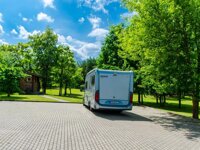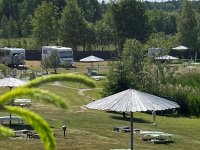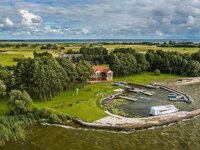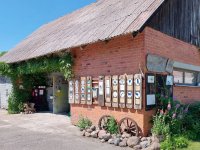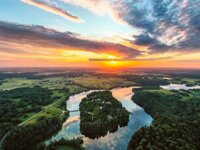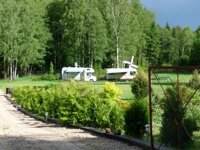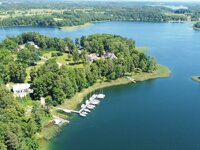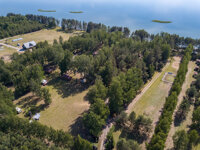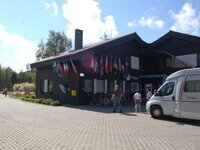Camping in Lithuania
9 campsites in Lithuania
Campsite Listing Google Map
The following consent is required:
Tracking & performance, Targeting & advertising.
Lithuania
As with the other Baltic states, Lithuania has remained relatively untouched by tourism. Its undulating landscapes, with their mixed forests, wetlands and scattering of lakes, make for remarkable walking and cycling. At the same time, the famous Curonian Spit is a popular place for beach lovers to visit, with its rippling dunes and sapphire waters.
The Lithuania campsites based near Vilnius are far enough from the city to have a rural feel but provide easy access to the capital. It's a curious blend of cobbled streets, Baroque architecture, modern restaurants, and clubs that suggests its rapid development since claiming independence from the Soviet Union.
Find locations for camping in Lithuania with Alan Rogers. Our listing includes sites in various parts of the country offering pitches and accommodation.
About Lithuania
Camping options in Lithuania

Lithuania offers several camping options for nature enthusiasts.
- Curonian Spit National Park: Located on the Baltic Sea coast, the Curonian Spit is a UNESCO World Heritage Site and a popular camping destination. The park features beautiful sandy beaches, coastal dunes, pine forests, and diverse wildlife.
- Aukštaitija National Park: In northeastern Lithuania, Aukštaitija National Park is known for its pristine lakes, dense forests, and cultural heritage. It's an excellent location for hiking, canoeing, and exploring traditional Lithuanian villages.
- Dzūkija National Park: Located in southern Lithuania, Dzūkija National Park is characterized by its lush forests, meandering rivers, and tranquil lakes. The park provides opportunities for those seeking a peaceful, immersive nature experience. Hiking trails, birdwatching, and mushroom picking are popular activities in the area.
- Trakai Historical National Park: Situated near the capital city of Vilnius, Trakai Historical National Park is known for its picturesque landscapes and the historic Trakai Island Castle. The park allows visitors to explore the beautiful lakes and forests while enjoying the area's rich cultural heritage.
When planning a camping trip in Lithuania, you should check the specific regulations and guidelines for camping in each park. It's also important to respect nature, follow Leave No Trace principles, and adhere to fire safety rules.
Additionally, private campsites and holiday resorts throughout Lithuania offer camping facilities and a range of amenities, including electricity, showers, and recreational activities.
Overall, Lithuania's natural beauty and diverse landscapes make it an excellent destination for camping, allowing you to immerse yourself in the country's stunning wilderness and enjoy outdoor activities.
Basic information
Lithuania is bordered by Latvia to the north, Belarus to the east and south, Poland to the south, and the Baltic Sea to the west. Its coastline stretches along the Baltic Sea for about 90 kilometres.
The landscape of Lithuania is primarily flat, with rolling plains and gentle hills dominating the central and western parts of the country. The eastern part of Lithuania features more undulating terrain and forests. Known for its abundant lakes, Lithuania has over 2,800 lakes scattered throughout the country. The largest and most famous is Lake Drūkšiai, located in the country's northeastern part. The Nemunas (Neman) River, the longest river in Lithuania, flows through the western part of the country, while the Neris River runs through the capital city, Vilnius.
Vilnius, Lithuania's capital and largest city, is located in the southeast. It is known for its well-preserved medieval old town, charming architecture, and cultural attractions. Other major cities include Kaunas, the second-largest city, Klaipėda on the Baltic coast, and Šiauliai in the northern part of the country.

Capital Vilnius
Currency Euro (EUR)
Language(s) Lithuanian
Time Zones EET (GMT+02)
Summer (EEST) (UTC+03)
Telephone Code +370
EU Member Yes
Schengen Area Yes
Tourism Websitelithuania.travel
Shopping in Lithuania
Lithuania offers a diverse shopping experience, from modern shopping centres to traditional markets.
- Vilnius: As the capital city, Vilnius offers a variety of shopping options. Gediminas Avenue is popular, with boutique shops, souvenir stores, and designer brands. The Akropolis and Panorama shopping centres provide various international and local retail brands and entertainment and dining options.
- Kaunas: As the second-largest city, Kaunas also boasts a thriving shopping scene. Laisvės Alėja, the city's main pedestrian street, has shops, department stores, and cafes. The Mega and Akropolis shopping centres in Kaunas offer a comprehensive shopping experience with numerous stores, eateries, and entertainment facilities.
- Traditional Markets: Lithuania also has traditional markets where you can experience the local culture and find unique products. The Hales Turgus market in Vilnius is a popular spot for fresh produce and traditional food items. Other markets, such as the Kaunas Central Market and Klaipėda Markets, offer a variety of goods ranging from clothing to local delicacies.
Souvenirs and Local Crafts: Consider purchasing traditional handicrafts and souvenirs in Lithuania. Baltic Amber, a fossilized tree resin, is a popular and cherished local product. You can find a wide range of amber jewellery, including necklaces, bracelets, and earrings. Linen products, woodcrafts, and ceramics are other popular choices for authentic Lithuanian souvenirs.
It's important to note that shopping hours in Lithuania typically follow regular business hours, with most shops closing around 6:00 p.m or 7:00 p.m. on weekdays and shorter weekends. Some shopping centres may have extended hours, including Sundays.
Visitors from non-European Union countries may be eligible for a VAT refund on certain purchases made in Lithuania. Look for participating stores that display the Tax-Free Shopping logo, and remember to ask for the necessary paperwork to claim the VAT refund at the airport upon departure.
Money in Lithuania
The official currency of Lithuania is the Euro (€), which is widely accepted throughout the country. Currency exchange services are available at banks, airports, exchange offices, and hotels. It's advisable to compare exchange rates and fees to ensure you get the best value when exchanging your currency for Euros.
ATMs are readily available in cities, towns, and tourist areas throughout Lithuania. They accept major international debit and credit cards such as Visa, Mastercard, and Maestro. ATM withdrawals provide a convenient way to obtain local currency at a competitive exchange rate. Be aware that some ATMs may charge a withdrawal fee, so checking with your bank regarding potential fees or charges is advisable.
Credit and debit cards are widely accepted in Lithuania, especially in hotels, restaurants, large retail stores, and tourist attractions. Visa and Mastercard are the most commonly accepted cards. It's a good idea to inform your bank or credit card provider about your travel plans to ensure smooth transactions and to inquire about any foreign transaction fees that may apply. While cards are widely accepted, carrying some cash is also advisable, especially when visiting smaller establishments, local markets, or rural areas where card acceptance may be limited. Cash can be helpful for small purchases, transportation, and in case of any unforeseen circumstances.
Tipping is not mandatory, but it is appreciated for good service. In restaurants, a typical practice is to round up the bill or leave a tip of around 5-10% of the total amount if you are satisfied with the service.
Lithuania Public Holidays
Lithuania celebrates several public holidays throughout the year.
- New Year's Day (Naujųjų metų diena) - January 1st
- Restoration of the State of Lithuania Day (Lietuvos valstybės atkūrimo diena) - February 16th
- Day of Restoration of Independence of Lithuania (from the Soviet Union) (Lietuvos nepriklausomybės atkūrimo diena) - March 11th
- Easter Monday (Antroji šv. Velykų diena) - the day after Easter Sunday (date varies)
- International Workers' Day (Tarptautinė darbo diena) - May 1st
- Mother's Day (Motinos diena) - the first Sunday in May
- Father's Day (Tėvo diena) - the first Sunday in June
- St. John's Day (Rasos ir Joninių diena) - June 24th
- Statehood Day (Valstybės diena) - July 6th
- Assumption Day (Žolinė) - August 15th
- All Saints' Day (Visų šventųjų diena) - November 1st
- All Souls' Day (Mirusiųjų atminimo (Vėlinių) diena) - November 2nd
- Christmas Eve (Šv. Kūčios) - December 24th
- Christmas Day (Šv. Kalėdos) - December 25th
- Boxing Day (Antroji Kalėdų diena) - December 26th
Government offices, schools, and many businesses may be closed on these public holidays or have limited operating hours. Some holidays, such as Easter Monday and Christmas Eve, are not official days off but are widely celebrated by families and communities. During public holidays, you may have the opportunity to witness local customs, traditions, and festivities. Special events, parades, concerts, and cultural activities may take place to celebrate these occasions.
When planning your visit to Lithuania, you should be aware of the public holidays that may occur during your stay, as they can affect the availability of certain services and the operating hours of businesses and attractions.
Driving in Lithuania

- Driving Side: Drive on the right-hand side of the road and overtake on the left. Dipped headlights must be used at all times.
- Driving License: Visitors must be 18 or older and hold a full valid driving license to drive in Lithuania. Driving licenses issued in EU and EEA countries are accepted.
- Speed Limits: Speed limits in Lithuania vary depending on the type of road and the vehicle you are driving. As a general guideline, the speed limits are:
- Urban areas: 50 km/h (31 mph)
- Unpaved roads: 70 km/h (43 mph)
- Open roads: 90 km/h (56 mph)
- Dual carriageways: 110 km/h (68 mph)
- Motorways: 130 km/h (80 mph)
Always observe the posted speed limit signs. Different limits may apply to cars towing trailers.
- Seat Belts:
- Wearing seat belts is mandatory for all passengers. Children under 12 are prohibited from occupying cars' front seats unless they are secured in a child restraint appropriate for their size. Children under three years old must be seated in a specially designed and approved seat suitable for their size. If the car is equipped with front airbags, it is not permitted to place a child in a rear-facing child seat on the front passenger seat.
- Mobile Phones: Using a handheld mobile phone while driving is illegal, except when using a hands-free system.
- Drink Driving: The legal blood alcohol content (BAC) limit for drivers in Lithuania is 0.04%. It is always recommended to avoid drinking and driving altogether.
- Winter Driving: It is compulsory to have winter tires fitted from November 10th to April 1st. Spiked tyres may be used from November 1st to April 9th. Vehicles with spiked tyres must display a sticker at the rear. This is highly recommended for foreign-registered vehicles.
- Tolls: Currently, there are no tolls for vehicles with fewer than eight occupants using roads in Lithuania.
- Compulsory Items: The following items are required when driving in Lithuania:
- Reflective jackets (which should be worn in case of breakdown)
- Warning triangle (compulsory in every vehicle)
- First aid kit and fire extinguisher
- Headlamp beam deflectors or adjustable headlights (depending on your car, you will either need deflector stickers or may have to adjust the beam manually)
- Parking: This is prohibited within 15 metres of a bus stop and 5 metres of a crossroads or junction. Ensure you do not park on tram lines in towns.
Lithuania Emergency Services
- Single European Emergency Number 112
- Fire service 101
- Police 102
- Ambulance Service 103
Emergency numbers can be reached free of charge from any phone in Lithuania. The European 112 Emergency Number can be called from locked mobile phones without entering a PIN.
Climate in Lithuania
Lithuania experiences a temperate climate with four distinct seasons.
- Spring (March to May): Spring in Lithuania is characterized by mild temperatures, ranging from cool to pleasantly warm. It's a transitional season with increasing daylight hours and occasional rainfall.
- Summer (June to August): Summers in Lithuania are generally mild to warm. Average temperatures range from 20°C to 25°C but can occasionally reach higher values. It's the sunniest and driest season, with longer daylight hours. It's an ideal time to explore outdoor activities and enjoy the beautiful Baltic Sea coast.
- Autumn (September to November): Autumn in Lithuania brings cooler temperatures and vibrant colours as the foliage changes. It starts with mild temperatures in September and gradually transitions into colder weather in November. Rainfall increases during this season.
- Winter (December to February): Winters in Lithuania are cold, with temperatures often dropping below freezing. Average temperatures range from -6°C to 0°C but can occasionally go lower. Snowfall is common, especially in the inland and eastern regions. It's a great time for winter sports enthusiasts to enjoy activities like skiing and ice skating.
The Baltic Sea significantly influences Lithuania's climate, bringing cool sea breezes in summer and keeping coastal areas cooler than inland regions.
